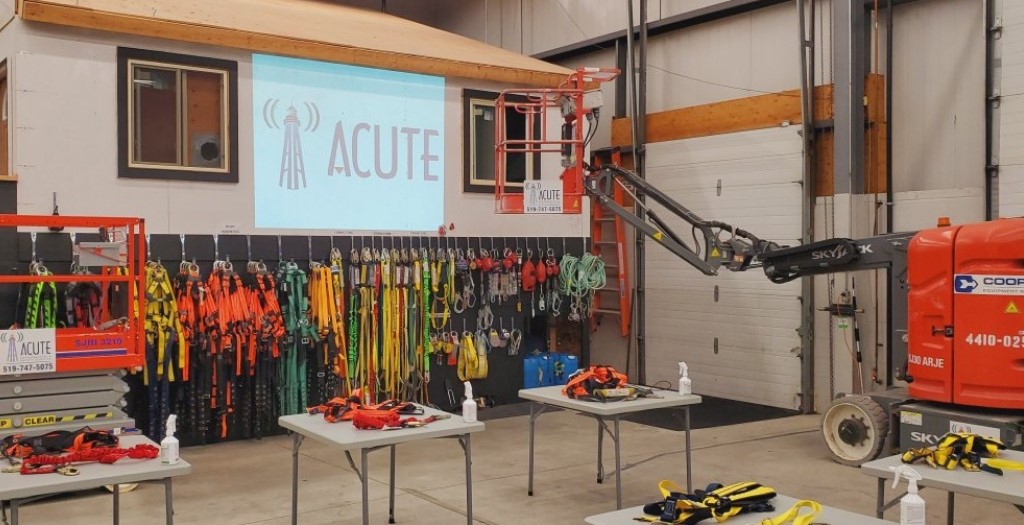The term HSE stands for: Health, Safety, and Environment. If you’ve ever wondered what HSE entails and how it applies to your workplace, this article is for you.
In this article, we are going to examine what HSE is and and outline each of the three components and relevant HSE safety training courses for each.
Click on each corresponding link to jump ahead:
- What Is HSE? – HSE is concerned with protecting the health and ensuring the safety of people in the workplace, as well as minimizing the impact of industrial activities on the environment.
-
- Health – Mitigating risks to physical and mental health.
- Safety – Preventing accidents, injuries, and fatalities.
- Environment – Limiting the impact of activities on the environment.
ACUTE Environmental is your go-to resource for all things safety training. Simply contact us today to set up your safety training!
What Is HSE?

Take the necessary steps to promote positive health and safety in the workplace while also considering environmental impacts.
HSE, or Health, Safety, and Environment, is a multidisciplinary field concerned with protecting the health and ensuring the safety of people in the workplace, as well as minimizing the impact of industrial activities on the environment. It involves the development and implementation of: policies, procedures, and regulations to safeguard the well-being of employees and the surrounding environment.
- Health: HSE professionals focus on identifying and mitigating risks to physical and mental health in the workplace. This includes addressing issues such as occupational diseases, exposure to hazardous materials, and promoting employee well-being through various programs.
- Safety: The safety aspect of HSE is centred on preventing accidents, injuries, and fatalities within the workplace. It involves the assessment and management of potential hazards, the implementation of safety protocols and training, and the promotion of a safety culture among employees.
- Environment: The environmental aspect of HSE involves managing the impact of industrial activities on the surrounding ecosystem. This includes measures to control pollution, reduce waste, conserve resources, and comply with environmental regulations to minimize the overall ecological footprint of the business or organization.
HSE professionals work to ensure that businesses operate in a manner that prioritizes the health and safety of their employees and stakeholders while also minimizing their environmental impact. Compliance with HSE standards is often mandatory in many industries to ensure sustainable and responsible practices.
Now, let’s examine each of these three components more critically.
1. Health
Health is a crucial aspect of HSE as it directly concerns the physical and mental well-being of individuals in the workplace.
Prioritizing health within the HSE framework is essential for fostering a productive and safe work environment, reducing the risk of illnesses, and promoting the overall welfare of employees.

Make sure you are taking the health of your employees seriously, it will benefit your overall reputation.
A) Why Health Is Important
- Employee Well-Being: Ensuring the health of employees fosters a positive work environment, leading to improved morale and productivity.
- Reduced Absenteeism: A focus on health can help prevent work-related illnesses and injuries, leading to fewer sick days and reduced absenteeism.
- Regulatory Compliance: Many jurisdictions have strict regulations regarding occupational health standards, and compliance with these regulations is essential to avoid legal consequences and maintain a good corporate reputation.
- Enhanced Reputation: Prioritizing employee health can improve the company’s reputation, making it an attractive place to work and potentially leading to greater employee retention and recruitment.
Now, let’s take a look at some health relevant HSE precautions and training courses.
B) Precautions and Safety Training
Proper Ergonomics Training: Teaching employees about correct posture, the importance of taking breaks, and how to set up their workstations ergonomically to prevent musculoskeletal disorders and other physical health issues.
Hazardous Material Handling Training: Providing education on the safe handling, storage, and disposal of hazardous materials to prevent exposure to harmful substances that could lead to long-term health issues.
- Check out our 40-hour HAZWOPER course to learn more.
Health Risk Assessment Programs: Implementing programs to assess and mitigate health risks in the workplace, such as regular health check-ups, monitoring of exposure to harmful substances, and addressing any identified health concerns promptly.
- If this sounds like something you need trained on, consider Worker Health and Safety Awareness and Supervisor Health and Safety Awareness training.
Mental Health Awareness and Support: Offering resources, workshops, and training to promote mental health awareness and resilience, reducing workplace stress, and providing support for employees facing mental health challenges.
First Aid and Medical Emergency Training: Providing employees with first aid training and ensuring that medical facilities or personnel are readily available in the workplace to handle any medical emergencies that may arise.
- For First Aid training, click here.
By implementing these precautions and training programs, companies can significantly reduce the risk of health-related issues in the workplace, creating a safer and more conducive environment for their employees.
2. Safety
The safety component of HSE is vital for protecting employees from accidents, injuries, and fatalities in the workplace.
Prioritizing safety within the HSE framework is essential for preventing potential hazards, maintaining a secure work environment, and promoting a culture of safety consciousness among employees.

Especially in industries where working at heights is essential, always promote workplace safety.
A) Why Safety Is Important
- Accident Prevention: A strong emphasis on safety reduces the likelihood of accidents and injuries, promoting a secure work environment for employees.
- Risk Mitigation: Implementing safety measures helps identify and mitigate potential risks and hazards, minimizing the probability of workplace incidents.
- Legal Compliance: Adhering to safety standards and regulations is crucial for avoiding legal liabilities and penalties associated with workplace accidents and injuries.
- Improved Productivity: Ensuring a safe work environment enhances employee confidence and morale, leading to increased productivity and overall job satisfaction.
- Enhanced Reputation: A commitment to safety fosters a positive company image, which can attract potential clients, partners, and employees, thereby enhancing the organization’s reputation.
Now, let’s examine some relevant HSE safety precautions and training courses.
B) Precautions and Safety Training
Safety Equipment Training: Providing comprehensive training on the proper use of personal protective equipment (PPE), such as helmets, goggles, gloves, and safety shoes, to minimize the risk of workplace injuries.
- Consider receiving HSE training on Respiratory Protection and Fit Testing.
Emergency Response Drills: Conducting regular drills to prepare employees for potential emergencies, such as fire drills, evacuation procedures, and first response training, to ensure a prompt and effective response in crisis situations.
- Consider HSE training courses like Spill Response and 40-Hour HAZWOPER.
Machine and Equipment Safety Training: Educating employees on the safe operation and maintenance of machinery and equipment, emphasizing the importance of following safety protocols and guidelines to prevent accidents and injuries.
- Take a look at HSE courses like Lift Truck Operator, Excavation, Trenching, and Shoring, and Overhead Crane.
Fall Prevention Programs: Implementing measures to prevent falls in the workplace, such as installing guardrails, providing fall protection equipment, and educating employees on proper techniques for working at heights.
- Examine HSE courses such as Working at Heights, Scaffolding and Ladder, and Lock-Out/Tag-Out.
Safety Audits and Inspections: Conducting regular safety audits and inspections to identify potential hazards, assess compliance with safety regulations, and proactively address any safety concerns within the workplace.
By implementing these precautions and safety training programs, companies can significantly reduce the risk of workplace accidents and injuries, creating a safer and more secure environment for their employees.
3. Environment
the environment component of HSE focuses on managing and minimizing the impact of industrial activities on the surrounding environment.
Prioritizing the environment within the HSE framework is essential for promoting sustainability, reducing pollution, conserving natural resources, and ensuring the long-term well-being of ecosystems.

Always try and limit your environmental impact by promoting safe handling practices.
A) Why Environment Considerations Are Important
- Sustainable Practices: Integrating environmental considerations into business operations promotes sustainable practices that minimize the depletion of natural resources and reduce the overall environmental footprint.
- Regulatory Compliance: Adhering to environmental regulations and standards is crucial for avoiding legal repercussions, fines, and damage to the company’s reputation.
- Ecosystem Protection: Implementing measures to protect the local ecosystem, including biodiversity, air quality, water resources, and natural habitats, helps preserve the environment for future generations.
- Community Relations: Demonstrating a commitment to environmental stewardship fosters positive relationships with local communities and stakeholders, enhancing the company’s public image and reputation.
- Cost Reduction and Efficiency: Implementing eco-friendly practices often leads to improved resource efficiency, reduced waste generation, and potential cost savings in the long run.
Now, we will take a look at some relevant environment HSE precautions and training courses.
B) Precautions and Safety Training
Waste Management Programs: Implementing effective waste management programs to minimize waste generation, promote recycling and reuse, and ensure the proper disposal of hazardous materials in accordance with environmental regulations.
- Evaluate HSE training courses like Transportation of Dangerous Goods, 40-Hour HAZWOPER, and Spill Response.
Energy Conservation Measures: Incorporating energy-efficient technologies, utilizing renewable energy sources, and encouraging energy-saving practices to reduce the overall carbon footprint and energy consumption of the organization.
Emission Control Strategies: Implementing emission control technologies and practices to minimize air pollution and greenhouse gas emissions, contributing to improved air quality and reduced environmental impact.
Environmental Impact Assessments: Conducting thorough environmental impact assessments before initiating new projects or activities to evaluate potential environmental risks and develop strategies to mitigate any adverse effects on the environment.
- Consider receiving HSE training on Asbestos – Advanced Awareness, Asbestos Abatement Supervisor 253 S Exam Preparation, Asbestos Abatement Worker 253 W Exam Preparation, and Asbestos Abatement Type 1 and 2 Operations.
Water Conservation Initiatives: Implementing water conservation measures, such as the use of water-saving technologies and practices, to minimize water consumption and prevent water pollution in the surrounding areas.
By integrating these precautions and environmental practices into their operations, businesses can actively contribute to environmental protection and sustainability, ensuring a more responsible and eco-friendly approach to their activities.
Trust ACUTE Environmental For HSE Training

ACUTE can transform your workplace to be more safety compliant.
If you are in charge of supervising health and safety in the workplace or you are concerned that your workplace is not safety complaint, book a course with ACUTE. Here are some of the benefits of working with ACUTE:
- Open Door Instructor-Student Partnership – ACUTE’s training services emphasize client participation, staff foster relationships with clients and serve as a touchstone for advice anytime moving forward.
- Serving Your Team and Industry – With a vast array of clients in manufacturing, construction, health, academic, and government sectors, ACUTE brings the best safety practices from across the spectrum to your workplace.
- 100 Years Combined Experience – ACUTE provides comprehensive health and safety training, on-site safety services, and consulting services. With over 100 years of combined experience, our company staff offers more than theoretical or abstract ideas. ACUTE offers solutions!
- Track Record of Success – ACUTE is rated 4.9/5 stars on Google reviews, demonstrating our commitment to our clients, our quality, and our passion for training.
It is one thing to know the necessary safety equipment you need but another to actually understand how to use it. Contact Acute Environmental today if you have any questions or concerns regarding your safety.
What Our Customers Are Saying…
We were referred to ACUTE on behalf of our employer for an n95 mask fitting – the staff here are professional, personable, and informative.
I’d come back here for any safety-related training in a heartbeat.
Acute has been a staple in supporting my companies over the years and have always delivered quality and dependable service. Training programs are top shelf and a great facility for practical application. couldn’t recommend them more. keep up the great work folks.
Outstanding service provided by Acute, right from the customer support end, right through to the delivery of the session. Always professional, quick to respond, and always delivering services that exceed my expectations. Acute has an amazing team that is always helping us achieve better health and safety performance. So are grateful to have such a tremendous resource in Acute!
Hours of Operation and Contact Information:
Monday-Friday: 8:00 AM – 5:00 PM
Saturday-Sunday: Closed
Phone: (519) 747-5075
Fax: (519) 747-4608
Email: info@acuteservices.com

